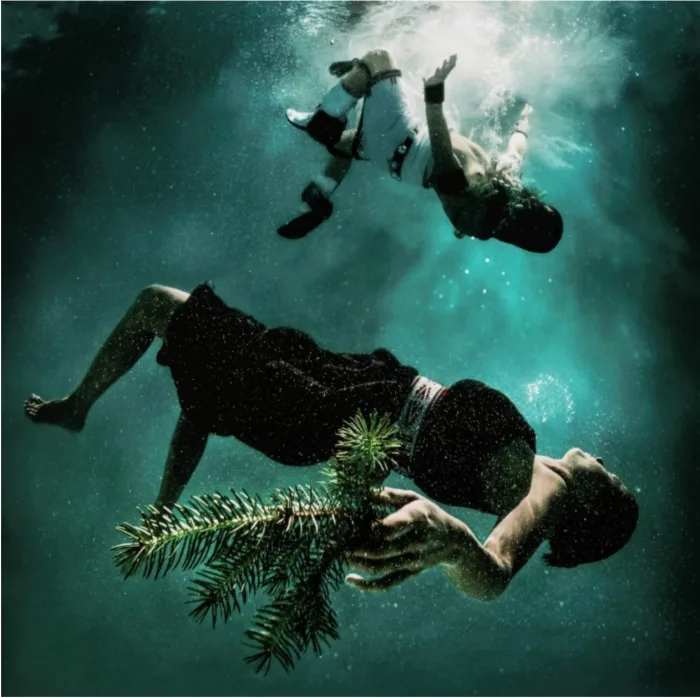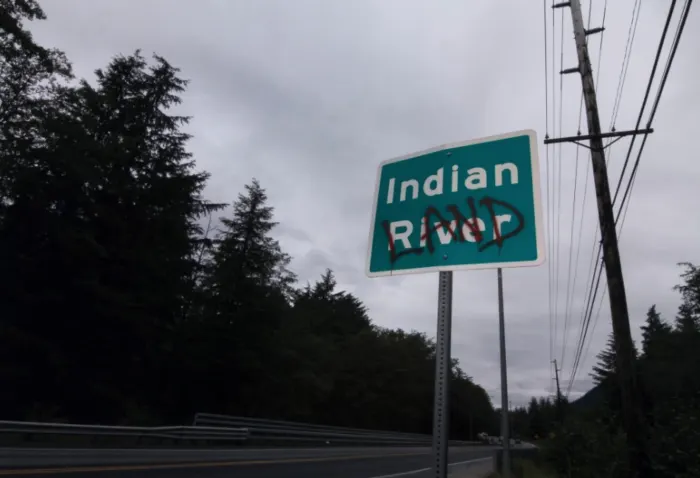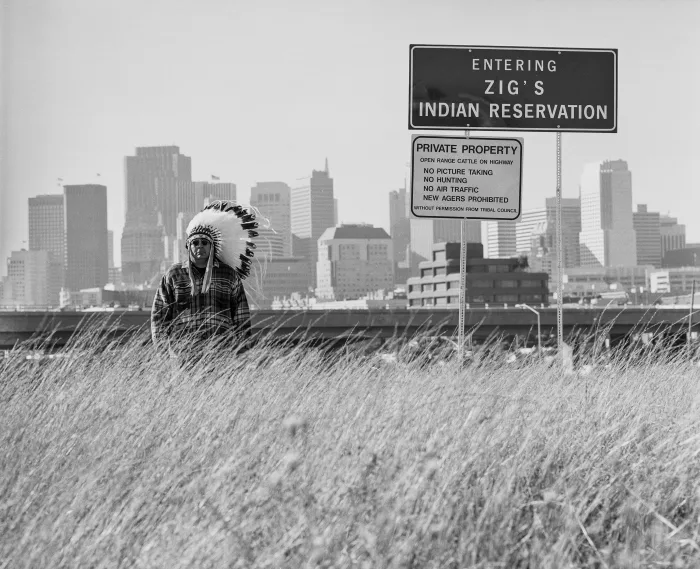News Based on facts, either observed and verified directly by the reporter, or reported and verified from knowledgeable sources.
Native photographers: Every picture tells a story
 This photo by Indigenous photographer Zig Jackson, "Indian Man on the Bus," or simply, "On the Bus," taken in San Francisco, explores the complexity of urban life for Indigenous people. It is part of an exhibit at the Denver Art Museum on Native photographers, "Speaking with Light: Contemporary Indigenous Photography,” which runs Feb. 19-May 21, 2023. It is also being featured at an exhibit of Jackson's works at North Dakota State University's Memorial Union Gallery through March 1, 2023. (Photo courtesy Denver Art Museum)
This photo by Indigenous photographer Zig Jackson, "Indian Man on the Bus," or simply, "On the Bus," taken in San Francisco, explores the complexity of urban life for Indigenous people. It is part of an exhibit at the Denver Art Museum on Native photographers, "Speaking with Light: Contemporary Indigenous Photography,” which runs Feb. 19-May 21, 2023. It is also being featured at an exhibit of Jackson's works at North Dakota State University's Memorial Union Gallery through March 1, 2023. (Photo courtesy Denver Art Museum)
New exhibits put spotlights on Indigenous photographers
Contemporary Indigenous photography has only recently been given a serious platform, as the more established crafts of painting and sculpture make up the more traditional exhibits.
In photos, Natives are more often the subject instead of the creator.
But three new exhibits put a spotlight on Indigenous photographers as they break down stereotypes and reflect the identity of Indigenous people while examining the photographers behind the camera.
“Developing Stories: Native Photographers in the Field,” is open now at the National Museum of the American Indian in New York City and runs through March 12.
“Speaking with Light: Contemporary Indigenous Photography” will open Feb. 19 at the Denver Art Museum and continue through May 21. It is among the first major museum shows to explore the practices of more than 30 Indigenous photographers working over the past decades.
“The Journey of Rising Buffalo,” which runs through March 1 at North Dakota State University’s Memorial Union Gallery, features an exhibit of photographs by Zig Jackson, some of whose works are also featured in the Denver exhibit.
Jackson, who is Mandan, Hidatsa, and Arikara, in 2021 became the first Native photographer to win a Guggenheim Fellowship, and a collection of his works has recently been selected for purchase by the Library of Congress. He often appears in his photographs wearing a headdress, such as in the well-known “Indian Man on the Bus” photo from 1994.
“Photography is powerful in its storytelling,” said Eric Paddock, curator of photography at the Denver museum and local curator of the exhibition.
“These photographs trace paths across time and place and reflect experiences that can shape and inform understanding of the past, the present and the future.”
‘Developing Stories’
“Developing Stories” is a series of three photo shows by photojournalists Donovan Quintero, Navajo; Tailyr Irvine, Confederated Salish and Kootenai Tribes; and Russel Albert Daniels, of Diné and Ho-Chunk descent.
The photographers share the same goals, “to break down stereotypes of Native peoples and portray diversity and the complexity of contemporary Native life,” according to the Smithsonian website.
Each photographer explores issues of deep personal interest to them in stories they cover for their own communities.
Their essays have poignant and compelling photography, of parents introducing their children to traditions, or a tattoo that proudly exclaims their heritage. They provide thought-provoking insights into contemporary Native life and nuanced perspectives to American experiences that are often invisible to mainstream society.
“The exhibition highlights the historically underrepresented views and voices of Indigenous communities,” according to the museum website. “The works aim to shift power dynamics and bring attention to misrepresentations by focusing on Indigenous perspectives, exploring themes of history, loss, identity, and representation.”
‘Speaking with Light’
“Speaking with Light” at the Denver Art Museum explores the practices of more than 30 Indigenous photographers who have been working over the past 30 years.
The exhibition was organized by the Amon Carter Museum of American Art in Fort Worth, Texas, with the Carter’s curator of photographs, John Rohrbach, joining with Diné artist and curator Will Wilson.
The works are arranged in thematic sections to explore different aspects of Indigeneity and reflect the more common experiences and feelings of Indigenous people. The photos explore history, loss, identity and representation.

“The Denver Art Museum looks forward to sharing this incredible selection of photography by Indigenous artists working today,” museum director Christoph Heinrich said in a statement.
“Our location on the homeland of the Arapaho, Cheyenne and Ute peoples underscores the importance of highlighting historically underrepresented views and voices of Indigenous communities,” he said. “The works in Speaking with Light aim to shift power dynamics and bring attention to misrepresentations by focusing on Indigenous perspectives.”
“Speaking with Light” presents photos from both emerging and established photographers, including Hulleah Tsinhnahjinnie, Taskigi/Diné; Wendy Red Star, Apsáalooke; Nicholas Galanin, Tlingit/Unangax̂;, and Jeremy Dennis, Shinnecock.
The show will include installations by artists Kapulani Landgraf, Kanaka ́Ōiwi; Jolene Rickard, Skarù:ręʔ/Tuscarora; and Alan Michelson, a Mohawk member of Six Nations of the Grand River.
In “Prologue: State to State,” the exhibition features photographs by White photographers when Indigenous leaders traveled to Washington, D.C. and brings them to the present day with photographer Will Wilson’s “Talking Tintype” portrait of Enoch Haney, former principal chief of the Seminole Nation in Oklahoma.

In “Survivance: An Ongoing Process,” photographers often use humor, pathos, and anger to defy erasure and stereotyping. The spray-painted sign in Nicholas Galanin’s “Get Comfortable,” from 2012, uses graffiti to insist on respect for Indigenous land rights. Galanin’s “Never Forget” installation that spelled out “Indian Land” was featured in a recent Desert X exhibition.
In “Nation,” relations of individuals to their communities become central to Indigenous identity. A photograph, “Joy Mask, IK” from 2018 by by Kiliii Yüyan’s, Nanai/Hèzhé and Chinese-American, shows how a mask that is created in a child’s classroom and patterned after traditional Yup’ik traditions, can transform and empower the one who wears it.
In “Indigenous Visualities,” the photographs aim to lift Indigenous voices by forging a deep connection with the natural world. The photographs include “Water Memory,” by Cara Romero, Chemeheuvi, from 2015, which has previously been exhibited at The Metropolitan Museum of Art in New York City.
‘The Journey of Rising Buffalo’
Jackson, also known as Rising Buffalo, addresses in his works the complexities of urban life as a Native person.
The North Dakota exhibit features 40 photos in an eight-part series that include perhaps his best-known works, “Entering Zig’s Indian Reservation.” Those photos are self-portraits showing Jackson occupying a variety of areas with handmade reservation signs.

The exhibit also includes “Indian Man on the Bus,” also known as “On the Bus,” in which he commutes nonchalantly with regularly dressed people in a graffiti-tagged bus. That photo is included both in the Denver and North Dakota exhibits.
“Jackson’s photos consider territorial claims, as well as dialog between the body – his own, of tourists, or the bodies of other Indigenous persons – and land, property, and signification,” according to an announcement about the North Dakota exhibit.
Anthony Faris, gallery coordinator and curator of collections at the Memorial Union Gallery at NDSU, said many of the photos were taken in the 1990s.
“In contemporary art, the photographer doesn’t have to touch the shutter anymore to be the photographer,” Faris told ICT. “They can be the director.”
The North Dakota exhibit ends on March 1, when Jackson will host a reception and give a talk at the gallery.
